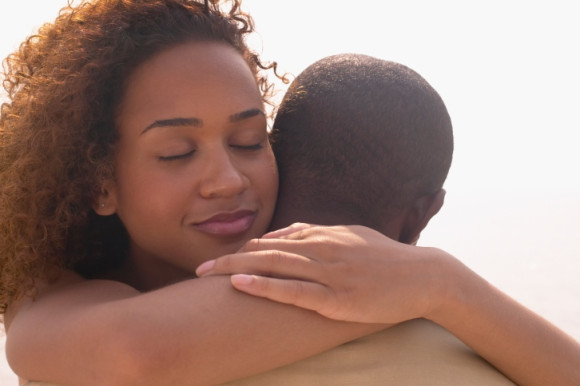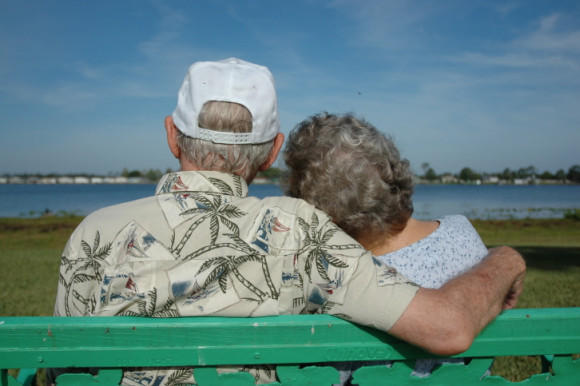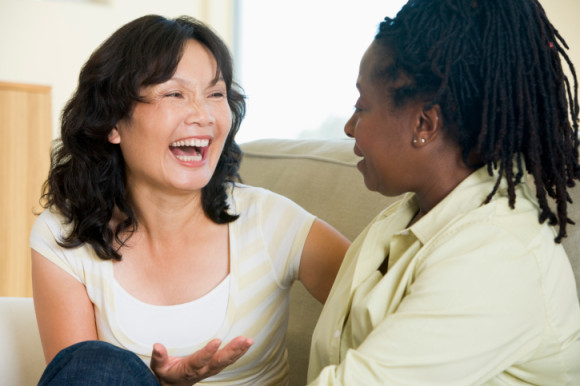Time Required
45 minutes each time you do this practice.
How to Do It
- Identify someone with whom you’d like to become closer. It could be someone you know well or someone you’re just getting to know. Although this exercise has a reputation for making people fall in love, it is actually useful for anyone you want to feel close to, including co-workers, family members, friends, and acquaintances. Before trying it, make sure both you and your partner are comfortable with sharing personal thoughts and feelings with each other.
- Find a time when you and your partner have at least 20-45 minutes free and are able to meet in person.
- For the first third of the time you have set aside for the activity, take turns asking one another the questions in Set I below. Each person should answer each question, but in an alternating order, so that a different person goes first each time.
- For the 2nd third of the time you have set aside, move on to Set II, even if you haven’t yet finished the Set I questions. Then spend that time on Set II, following the same system.
- After the 2nd third of the time you have set aside on Set II, spend that time on Set III. (Note: Each set of questions is designed to be more probing than the previous one. The time periods ensure that you spend an equivalent amount of time at each level of self-disclosure).
Set I
1. Given the choice of anyone in the world, whom would you want as a dinner guest?
2. Would you like to be famous? In what way?
3. Before making a telephone call, do you ever rehearse what you are going to say? Why?
4. What would constitute a “perfect” day for you?
5. When did you last sing to yourself? To someone else?
6. If you were able to live to the age of 90 and retain either the mind or body of a 30-year-old for the last 60 years of your life, which would you want?
7. Do you have a secret hunch about how you will die?
8. Name three things you and your partner appear to have in common.
9. For what in your life do you feel most grateful?
10. If you could change anything about the way you were raised, what would it be?
11. Take four minutes and tell your partner your life story in as much detail as possible.
12. If you could wake up tomorrow having gained any one quality or ability, what would it be?
Set II
13. If a crystal ball could tell you the truth about yourself, your life, the future, or anything else, what would you want to know?
14. Is there something that you’ve dreamed of doing for a long time? Why haven’t you done it?
15. What is the greatest accomplishment of your life?
16. What do you value most in a friendship?
17. What is your most treasured memory?
18. What is your most terrible memory?
19. If you knew that in one year you would die suddenly, would you change anything about the way you are now living? Why?
20. What does friendship mean to you?
21. What roles do love and affection play in your life?
22. Alternate sharing something you consider a positive characteristic of your partner. Share a total of five items.
23. How close and warm is your family? Do you feel your childhood was happier than most other people’s?
24. How do you feel about your relationship with your mother?
Set III
25. Make three true “we” statements each. For instance, “We are both in this room feeling…"
26. Complete this sentence: “I wish I had someone with whom I could share…"
27. If you were going to become a close friend with your partner, please share what would be important for them to know.
28. Tell your partner what you like about them; be very honest this time, saying things that you might not say to someone you’ve just met.
29. Share with your partner an embarrassing moment in your life.
30. When did you last cry in front of another person? By yourself?
31. Tell your partner something that you like about them [already].
32. What, if anything, is too serious to be joked about?
33. If you were to die this evening with no opportunity to communicate with anyone, what would you most regret not having told someone? Why haven’t you told them yet?
34. Your house, containing everything you own, catches fire. After saving your loved ones and pets, you have time to safely make a final dash to save any one item. What would it be? Why?
35. Of all the people in your family, whose death would you find most disturbing? Why?
36. Share a personal problem and ask your partner’s advice on how they might handle it. Also, ask your partner to reflect back to you how you seem to be feeling about the problem you have chosen.
You can try this practice with different people you want to develop a deeper connection with—but if your answers start to feel routine, consider making up your own list of questions that become increasingly more personal. Two couples can also try this practice together, which has been shown to increase closeness between the couples in addition to enhancing closeness and passionate love within each couple.
Why You Should Try It
Building close relationships in adulthood can be challenging. Many social situations call for polite small talk, not heart-to-heart conversations, making it difficult to really connect deeply with people.
One way to overcome these barriers to closeness is by engaging in “reciprocal self-disclosure”—that is, to reveal increasingly personal information about yourself to another person, as they do the same to you. Research suggests that spending just 45 minutes engaging in self-disclosure with a stranger can dramatically increase feelings of closeness between you. In some cases, these feelings of closeness persist over time and form the basis of a new relationship.
Why It Works
To develop closeness, we need to be willing to open up. But opening up isn’t always easy—we might fear coming on too strong or embarrassing ourselves. The 36 Questions encourage us to open up at the same time and at a similar pace as our partner, reducing the likelihood that the sharing will feel one-sided. It offers space for our partner to respond positively to our self-disclosure—with understanding, validation, and care—in a way that can also enhance closeness. This mirrors the gradual getting-to-know-you process that relationships typically undergo, only at a more accelerated pace. The feelings of closeness generated can, in turn, help us build lasting relationships that increase our overall happiness.
Evidence That It Works
Aron, A., Melinat, E., Aron, E. N., Vallone, R. D., & Bator, R. J. (1997). The experimental generation of interpersonal closeness: A procedure and some preliminary findings. Personality and Social Psychology Bulletin, 23(4), 363-377.
Unacquainted pairs of participants instructed to ask one another the 36 Questions for Increasing Closeness reported a greater increase in feelings of closeness than pairs instructed to ask one another 36 superficial questions instead. Pairs who completed the closeness exercise felt closer regardless of whether they shared certain core beliefs and attitudes, or whether they expected the exercise to work in the first place. Remarkably, their feelings of closeness following the conversation matched the average level of closeness that other participants reported feeling in their closest relationships.
Who Has Tried the Practice?
While there is no demographic information in the original 1997 study, additional studies explore how this exercise benefits different groups and cultures, including how it can reduce social prejudice and its consequences:
- Undergraduate freshmen in Germany grew fonder of each other and felt more socially integrated at school after completing 36 Questions virtually with a partner, regardless of differences in migration status, disability status, age, or sexual orientation.
- White, heterosexual, English-speaking undergraduate students in the northeastern United States improved in attitudes toward gay men and lesbian women, experienced more positive feelings of interpersonal closeness, and showed more friendliness after they completed a version of this exercise with a partner who disclosed their homosexuality.
- Latino and white undergraduate students who were high in unconscious racial prejudice (or highly concerned about rejection based on their race) experienced reductions in stress biomarkers when completing 36 Questions, particularly in cross-race pairs. 36 Questions also helped some students seek out more interracial interactions and feel less anxious in their diverse university setting.
- Non-Roma undergraduate students in Hungary with “fairly negative” attitudes toward the Roma developed more positive attitudes toward them after performing 36 Questions with a Roma student for one hour.
More research is needed to explore whether, and how, the impact of this practice extends to other groups and cultures.
Keep in Mind
Taking turns to answer each question may be the most beneficial approach to 36 Questions, instead of each person answering all 36 questions in a row. When pairs of undergraduate students in the Midwestern United States performed this practice, those who took turns reported liking each other more, feeling closer and more similar, and enjoying the activity more than pairs who had one speaker at a time.
People who have clinically low social motivation—the drive to interact with and be accepted by others—may not experience the full benefits of 36 Questions. There is evidence that individuals with schizophrenia and social anhedonia (a type of major depression that leads to avoidance of social interactions) may experience less positive emotion during 36 Questions than individuals without any psychiatric diagnoses.
Sources
Arthur Aron, Ph.D., Stony Brook University
References
Kende, A., Tropp, L., & Lantos, N. (2017). Testing a contact intervention based on intergroup friendship between Roma and non-Roma Hungarians: Reducing bias through institutional support in a non-supportive societal context. Journal of Applied Social Psychology, 47(1), 47–55.
Lytle, A., & Levy, S. R. (2015). Reducing heterosexuals’ prejudice toward gay men and lesbian women via an induced cross-orientation friendship. Psychology of Sexual Orientation and Gender Diversity, 2(4), 447–455.
Martin, E. A., Castro, M. K., LiID, L. Y., Urban, E. J., & Moore, M. M. (2019). Emotional response in schizophrenia to the “36 questions that lead to love”: Predicted and experienced emotions regarding a live social interaction. PLoS ONE, 14(2), 13.
Page‐Gould, E., Mendoza‐Denton, R., & Mendes, W. B. (2014). Stress and coping in interracial contexts: The influence of race‐based rejection sensitivity and cross‐group friendship in daily experiences of health. Journal of Social Issues, 70(2), 256–278.
Page-Gould, E., Mendoza-Denton, R., & Tropp, L. R. (2008). With a little help from my cross-group friend: Reducing anxiety in intergroup contexts through cross-group friendship. Journal of Personality and Social Psychology, 95(5), 1080–1094.
Sprecher, S., Treger, S., Wondra, J. D., Hilaire, N., & Wallpe, K. (2013). Taking turns: Reciprocal self-disclosure promotes liking in initial interactions. Journal of Experimental Social Psychology, 49(5), 860.
Stürmer, S., Ihme, T. A., Fisseler, B., Sonnenberg, K., & Barbarino, M. (2018). Promises of structured relationship building for higher distance education: Evaluating the effects of a virtual fast-friendship procedure. Computers & Education, 124, 51–61.
Practicing 36 Questions for Increasing Closeness can help nurture your relationships. How strong are your social connections? Take our Social Capital quiz to find out:







Comments
and Reviews
Harry
I find this disturbing. There are several questions here that are potentially distressing for anyone carrying serious trauma, as a result, for instance, of violence or childhood abuse. 10. if you could change anything about the way you were raised .. 18. your most terrible memory 23. childhood & family .. close? warm? It's particularly worrying that one of the most potentially triggering questions comes in the first set. I realise these are questions designed to enable people to get close to each other by revealing things about themselves. But some of these questions are simply not safe to ask someone in an environment without support present to care for them should there be an adverse reaction. For anyone carrying trauma, social trust is difficult or even impossible, and these questions, this process, demand very high levels of social trust towards someone who, at the start of the process, you don't know in any significant depth. This process, the questions, the way that the exercise is designed, is simply not trauma-aware. Without careful framing, careful caveats for people with trauma, it is irresponsible. The only caveat here is 'Before trying it, make sure both you and your partner are comfortable with sharing personal thoughts and feelings with each other', and that is wholly inadequate. There simply is no way with a stranger to 'make sure', while there are many ways in which someone carrying trauma can be led into feeling obliged to go along, and that can happen without any malicious intent. There's' no simple fix for this problem. The process outlined here is fundamentally unethical.
Sofia Juarez
Rui-Hong You
Keicia Christine Bass-Goodman
Laura Elena Rivera Aragón
Muy interesante propuesta la llevaré a cabo proximamente
Chris Rivera
The Greater Good Toolkit
Made in collaboration with Holstee, this tookit includes 30 science-based practices for a meaningful life.
The Greater Good Toolkit
Made in collaboration with Holstee, this tookit includes 30 science-based practices for a meaningful life.